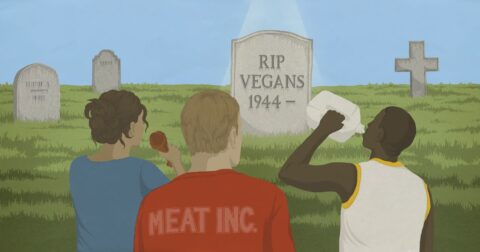What Surprised Us Most in 2025
Food•4 min read
Perspective
The massive scale and influence of the meat industry shouldn’t be underestimated.

Perspective • Food • Industry

Words by Jessica Scott-Reid
It was 2020, and documentaries like What the Health and The Game Changers — released a couple of years earlier — were opening eyes to the benefits of eating a plant-based diet. Beyond Meat had just gone public to major fanfare, and oat milk was the trendy new option at corner coffee shops. The cultural message was clear: Being vegan was cool.
Today, headlines suggest the opposite. In March, The Atlantic reported that “Plant-based eating has lost its appeal.” Earlier this month, The Guardian reported that “Vegan burgers are losing the culture war over meat.” And in an August Financial Times opinion piece, “Why the vegans lost,” Henry Mance wrote that “meat-free advocates were relying on mass conversion … that isn’t happening,” adding that vegans could never win because they “were trying to upturn thousands of years of human cuisine.”
There are definitely data points to support this conclusion. Beyond Meat is rebranding in the wake of a major financial bailout, vegan restaurants are closing or adding meat to their menus, and meat consumption — namely chicken — is higher in the U.S. than ever before.
However, these eulogies for veganism tend to downplay this critical point: taking on the meat industry — a monster machine with unparalleled lobbying and marketing resources — was never a fair fight.
In 2024, the U.S. meat industry made nearly $300 billion in revenue combined. Americans consumed nearly 230 pounds of meat and poultry per capita that year. These numbers dwarf those from the plant-based alternatives sector, which was valued at just under $4 billion the same year.
This goes beyond market demand. To keep meat on the tables of Americans, meat processing industry lobbyists collectively spent $5.5 million in Washington, D.C. in 2024. Their goal is to influence regulatory agencies, and it works. According to a 2023 report by Stanford University, about 800 times more public funding and 190 times more lobbying money went to meat and dairy than to plant-based and cell-cultivated alternatives between 2014 and 2020. The researchers found that U.S. policy overwhelmingly favored livestock farming — channeling more funding toward animal and feed production. From the start, novel meat alternatives were at a disadvantage against the industry’s entrenched dominance.
The labels “plant-based” and “vegan” are often used interchangeably, but they are not always the same. While plant-based typically refers to a diet centered on plants that may still include some animal products, veganism — first coined in 1944 — is an ethical lifestyle that tends to go further by avoiding all animal-derived products where possible, including food, cosmetics and textiles.
The success or failure of the vegan movement cannot be measured solely by profit, market power or the popularity of a diet trend. When interest in flexitarianism surged in the early 2020s, it was fueled by non-vegans trying plant-based alternatives, like Beyond Meat. The cooling popularity of plant-based foods among flexitarians then, isn’t necessarily a failure — it mirrors the predictable rise and fall of market interest in new innovations.
Plant-based meat alternatives are also considered a new technology, and their rise and fall mirrors the classic innovation hype cycle seen in the tech sector. After an initial surge of excitement and investment, early adoption typically slows as the products face scrutiny. In the case of plant-based meats, the products still fall behind on taste, price and convenience, among other factors. As a new technology, this downturn may suggest failure, but in reality, it reflects a predictable stage in how most new technologies mature.
While these patterns may help explain why growth in the plant-based food sector has slowed, there is more to this story. Consumer engagement with plant-based alternatives is also shaped by external factors, including meat industry disinformation campaigns that are aimed at shaping perceptions and curbing the sector’s momentum — a strategy backed by substantial lobbying and market power.
Since the rise in popularity of plant-based meat alternatives, the meat industry has actively campaigned to undermine them, portraying these products as unhealthy and unnatural. Through targeted advertisements and websites — such as Clean Food Facts, created by the Center for Consumer Freedom — meat-backed efforts have painted plant-based meats as synthetic and ultra-processed. In 2020, full-page ads by the Center ran in The New York Times and Wall Street Journal, claiming “fake meats” are full of “real chemicals.” These accompanied a $5 million TV ad broadcast to select markets during the 2020 Super Bowl that mocked plant-based meat and urged viewers to distrust ingredients like methylcellulose — a common food additive also found in bread and ice cream. Bloomberg has described CCF as a front group for meat, tobacco and alcohol companies. The Center is led by ex-tobacco lobbyist Richard Berman, whom the Guardian has described as the food industry’s “weapon of mass destruction,” who has “waged campaigns against animal welfare groups, labor unions and even Mothers Against Drunk Driving.”
Some plant-based meat alternatives are indeed processed, or even ultra-processed. And although this terminology has been weaponized in recent years, evaluating a food’s healthfulness requires more than how it’s processed or the ingredient lists. For example, a 2025 review of scientific literature in The American Journal of Clinical Nutrition found that replacing animal meat with processed plant-based meat alternatives may improve cholesterol and support heart health in adults without cardiovascular disease.
In stark contrast to the U.S., Denmark offers a compelling example of how government support can guide cultural acceptance of plant-based diets through integration rather than replacement. In 2023, the country launched the world’s first national action plan for plant-based foods, investing €170 million ($200.4 million USD) to strengthen the industry, from farming and innovation to public procurement and culinary education. Rather than framing it as a threat to meat, the plan sidesteps polarizing labels like “vegan” or “vegetarian” and avoids setting targets to cut meat consumption. Plant-based options are presented as a business opportunity and climate-smart choice. This positions the plant-based sector as complementary, rather than disruptive to the meat industry.
This is not the time for a plant-based post-mortem. The health of the plant-based food market — or of Beyond Meat alone — does not reflect the broader potential of plant-forward diets to shift culture, reduce impact on climate change and improve health. Nor does it indicate whether vegans have “won” or “lost,” as the Atlantic reported and Mance argues in the Financial Times earlier this year. Success is not measured by short-term sales spikes or viral trends. It comes from steady integration, with plant-based foods becoming normalized, accessible and appealing.